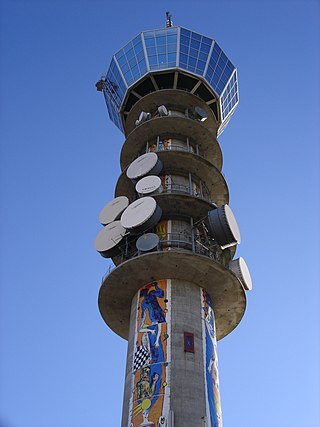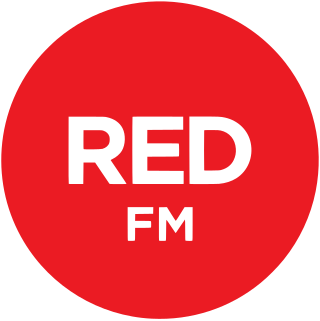India's telecommunication network is the second largest in the world by number of telephone users with over 1.1 billion subscribers as of December 2023. It has one of the lowest call tariffs in the world enabled by multiple large-scale telecom operators and the ensuant hyper-competition between them. India has the world's second largest Internet user-base with over 904 million broadband internet subscribers as of December 2023.
Modern telecommunications in Thailand began in 1875 with the deployment of the first telegraph service. Historically, the development of telecommunication networks in Thailand were in the hands of the public sector. Government organisations were established to provide telegraph, telephone, radio, and television services, and other government agencies, especially the military, still control a large estate of radio and television spectra. Private telecommunication operators initially acquired concession agreements with state enterprises. For mobile phone services, all the concessions have been amended by successive government to last 25 years have gradually ended in 2015. For other services, the concession terms and conditions vary, ranging from one to fifteen years. Nearly all of the concessions are build-operate-transfer (BTO) contracts. The private investor has to build all the required facilities and transfer them to the state before they can operate or offer services to public.

Shortwave radio is radio transmission using radio frequencies in the shortwave bands (SW). There is no official definition of the band range, but it always includes all of the high frequency band (HF), which extends from 3 to 30 MHz ; above the medium frequency band (MF), to the bottom of the VHF band.

Very high frequency (VHF) is the ITU designation for the range of radio frequency electromagnetic waves from 30 to 300 megahertz (MHz), with corresponding wavelengths of ten meters to one meter. Frequencies immediately below VHF are denoted high frequency (HF), and the next higher frequencies are known as ultra high frequency (UHF).

Radio broadcasting is the broadcasting of audio (sound), sometimes with related metadata, by radio waves to radio receivers belonging to a public audience. In terrestrial radio broadcasting the radio waves are broadcast by a land-based radio station, while in satellite radio the radio waves are broadcast by a satellite in Earth orbit. To receive the content the listener must have a broadcast radio receiver (radio). Stations are often affiliated with a radio network that provides content in a common radio format, either in broadcast syndication or simulcast, or both. The encoding of a radio broadcast depends on whether it uses an analog or digital signal. Analog radio broadcasts use one of two types of radio wave modulation: amplitude modulation for AM radio, or frequency modulation for FM radio. Newer, digital radio stations transmit in several different digital audio standards, such as DAB, HD radio, or DRM.

The FM broadcast band is a range of radio frequencies used for FM broadcasting by radio stations. The range of frequencies used differs between different parts of the world. In Europe and Africa and in Australia and New Zealand, it spans from 87.5 to 108 megahertz (MHz) - also known as VHF Band II - while in the Americas it ranges from 88 to 108 MHz. The FM broadcast band in Japan uses 76 to 95 MHz, and in Brazil, 76 to 108 MHz. The International Radio and Television Organisation (OIRT) band in Eastern Europe is from 65.9 to 74.0 MHz, although these countries now primarily use the 87.5 to 108 MHz band, as in the case of Russia. Some other countries have already discontinued the OIRT band and have changed to the 87.5 to 108 MHz band.

Radio Mirchi, also known as 98.3 Mirchi, is a nationwide network of private FM radio stations in India. It is owned by the EntertainmentNetwork India Ltd (ENIL), which is one of the subsidiaries of The Times Group. The tagline of Radio Mirchi is "Mirchi Sunnewaale Always Khush!". It is the first privately owned radio station in India.

Community radio is a radio service offering a third model of radio broadcasting in addition to commercial and public broadcasting.
Pirate radio stations have operated in various countries of Asia, often putting over political or nationalist points of view. Offshore stations have attempted to reach China or overseas Chinese residents. Citizens' Radio is an unlicensed Hong Kong pro-democracy station. In Taiwan, what are known as "underground radio" stations have broadcast both pro- and anti-government opinions. Large numbers of unlicensed stations have functioned in the Philippines, of which 107.9 U-Radio (2006–2013) is among the best known. Finally, Radio First Termer was briefly operated by and for U.S. troops in Vietnam in 1971.

FM broadcasting is a method of radio broadcasting that uses frequency modulation (FM) of the radio broadcast carrier wave. Invented in 1933 by American engineer Edwin Armstrong, wide-band FM is used worldwide to transmit high-fidelity sound over broadcast radio. FM broadcasting offers higher fidelity—more accurate reproduction of the original program sound—than other broadcasting techniques, such as AM broadcasting. It is also less susceptible to common forms of interference, having less static and popping sounds than are often heard on AM. Therefore, FM is used for most broadcasts of music and general audio. FM radio stations use the very high frequency range of radio frequencies.
A broadcast license is a type of spectrum license granting the licensee permission to use a portion of the radio frequency spectrum in a given geographical area for broadcasting purposes. The licenses generally include restrictions, which vary from band to band.
The FM broadcasting in India began in 1977; growing popularity after 2001 when the privatisation of FM broadcasting began. AIR's FM LRS was inaugurated on 1 July 2000 at 06:00 in Kodaikanal relaying Madurai programs in the frequency 100.5 MHz. 100.5 was so popular that LRS was upgraded to an FM Channel in just two months. The channel covered a radius of about 200 km (120 mi) due to its location at 2200 meters above MSL at Kodaikanal. KODAI FM is popularly known as it is the biggest individual FM channel in India, in both area coverage and listenership.

Media in Goa refers to the newspapers, magazines, radio stations, cable and television networks and online media in India's smallest state. Over the past two-and-half decades, the Goa-linked online media has also grown.
Gyan Vani is an educational FM radio station in several cities of India.
Band I is a range of radio frequencies within the very high frequency (VHF) part of the electromagnetic spectrum. The first time there was defined "for simplicity" in Annex 1 of "Final acts of the European Broadcasting Conference in the VHF and UHF bands - Stockholm, 1961". Band I ranges from 47 to 68 MHz for the European Broadcasting Area, and from 54 to 88 MHz for the Americas and it is primarily used for television broadcasting in compliance with ITU Radio Regulations. With the transition to digital TV, most Band I transmitters have already been switched off.

Red FM is a defunct Malaysian English language-private radio station that used to broadcast across Peninsular Malaysia and Singapore. It was managed by Star Media Radio Group, a wholly owned subsidiary of Star Publications (M) Bhd. Red FM began broadcasting on 1 September 2001 and was one of Malaysia's top five English radio stations.
In India, the Department of Telecommunications (DoT) conducts auctions of licenses for electromagnetic spectrum. India was among the early adopters of spectrum auctions beginning auctions in 1994.
Direct-to-Home (DTH) television is a method of receiving satellite television by means of signals transmitted from direct-broadcast satellites. The Government of India (GoI) permitted the reception and distribution of satellite television signals in November 2000. The first DTH service in the country was launched by Dish TV on 2 October 2003. DD Free Dish, the first free DTH service in India, was launched by public broadcaster Prasar Bharati in December 2004.
Broadcasting in the city of Chennai began in 1924 by the Madras Presidency Radio Club. The service was operational till the government-run All India Radio started broadcasting in the city in 1938.









